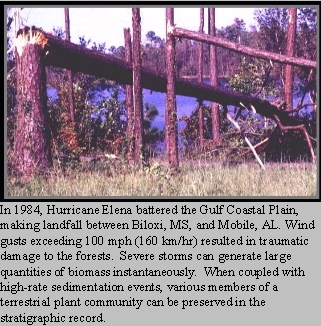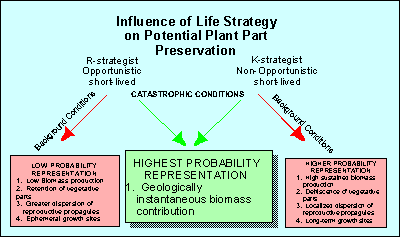PLANT TAPHONOMY
TAPHOS - is Greek for Death
TAPHONOMY - Study of processes of preservation and how they affect information in the fossil
record. Taphonomy encompasses processes between "death" of an organism
and the recovery at the outcr
Taphonomic Processes Play The Underlying Role in the
Characteristics of Fossil Plant Assemblages
Plant life strategy, habitats and ecological associations, original
biochemical constituents, and the nature of depositional regimes have an
effect on plant part representation in subfossil (< 10,000 YBP) and
fossil assemblages.
SUBDISCIPLINARY STUDIES WITHIN TAPHONOMY INCLUDE:
- Necrology,
- Biostratinomy, and
- Diagenesis
NECROLOGY - Generally thought of as the Death of an individual. In most
cases, entire plants DO
NOT die in toto, but shed parts during their life
cycle. These parts have the greatest potential for
preservation within the stratigraphic record.
There are three process categories under which plant parts may become subject to fossilization.
 NECROLOGICAL - The actual death of an individual or loss of vegetative and/or reproductive
parts.
NECROLOGICAL - The actual death of an individual or loss of vegetative and/or reproductive
parts.
- Low stature plants are subjected to preservation in their entirety when existing in areas of high
depositional rates.
- Arborescent plants may be preserved in situ (in growth position) when subjected to anomalously
high depositional rates.
- These ultimately cause the DEATH of the individual.
- Individual Death or Organ Dispersal
Vast quantities of biomass are lost from a parent plant either through
physiological or traumatic mechanisms without necessarily causing plant
death. These plant parts include the majority of specimens that become
our data base.
PHYSIOLOGICAL - The loss of plant parts in response to a biotic mechanism.
- Abscission during growth or climatic seasonality
- Bark shedding resulting from volumetric growth
- Dispersal of reproductive organs.
TRAUMATIC - The loss of plant parts in response to an abiotic (physical) mechanism.

- Provides a high quantity of biomass in geologically instantaneous events.
- Defoliation during high winds and rainfall (hurricanes, typhoons).
- Synusial (diversity of growth habits), histological, and morphological features of the plants
are important with regard to contribution to fossil assemblages.
- The timing of plant part loss (either physiologically induced or climatically induced) when coupled
with anomalous, high-rate depositional events may bias the sample population of organs.
- Most canopy litter generated is decomposed at a rate that is dependent mostly upon climate.
- Plant parts must be introduced to, or already reside (e.g. rooting structures) within, sites
that are conducive towards preservation. These sites reduce the probability of biotic
interactions usually by their inhospitable conditions.
BIOSTRATINOMY - The interaction of plant parts with sedimentary processes and the ultimate
burial and incorporation of macrodetritus in sedimentary rocks.

Autochthonous assemblages - This refers to the preservation of plants either in situ (in growth
position) or in their site of growth. The only transport that may be implied is the fall of the canopy
parts to the sediment interface below.
- Underground parts (roots, rhizomes, root-like structures) are already buried and if conditions are
amenable for preservation, they may be fossilized by a variety of mechanisms.
- Rooting structures may be shallowly or deeply implanted in the substrate.
- Those that are generally shallow are most likely not to be preserved, whereas those that are
more deeply buried during life have a greater likelihood of preservation (bodily preservation
including permineralizations; coaly film in a collapsed root; casting; drab halos;
rhizoconcretions).
- Erect aerial parts are linked to high-rate sedimentological events including volcaniclastic burial,
mudflows, valley infilling, and catastrophic flooding. Burial in vertical orientation may or may
not be a valid criterion for identifying autochthonous assemblages.

Parautochthonous burial - This implies a minimum of transport from the site of growth; those having
been transported from the death or discard site but remaining within the original habitat before burial
and preservation (see: Behrensmeyer & Hook, 1992).
Allochthonous assemblages - This involves the transport of plant parts away from their site of growth
before burial.
- Transport is facilitated either by wind, water, or a combination.
- Mass movements in certain environments of deposition may entrain macrodetritus and transport it
significant distances.

BURIAL - involves the covering and/or inclusion of plant detritus within a sediment such that the
organic matter is isolated from the effects of biological degradation.
- Burial can occur over geologically instantaneous intervals, or over longer periods of time.
- The structural integrity and resistance to degradation of any particular plant part will ultimately
determine its residence time and potential for long term burial.
DIAGENESIS - Processes involving physical and chemical changes in sediment (and that which is
incorporated in the sediment) after deposition that converts it to consolidated rock. This includes
compaction, cementation, and recrystallization.
- Pore-water interactions may be occur early, soon after burial.
- Very early diagenetic interactions (10-0 to 10-1) may result in siderite concretions or
pyritizations.
- Longer term interactions (10-3 to 10-5) may result in permineralization, lignification
(coalification requires longer time intervals under elevated temperatures and pressures), and
compaction.
©
Copyright 1997 by Robert A. Gastaldo. All rights reserved. No part of
these lecture notes may be reproduced or transmitted in any form or by any
means, electronic or mechanical, including photocopy, recording, or any
information storage and retrieval system, without permission from the
author.


 NECROLOGICAL - The actual death of an individual or loss of vegetative and/or reproductive
parts.
NECROLOGICAL - The actual death of an individual or loss of vegetative and/or reproductive
parts. NECROLOGICAL - The actual death of an individual or loss of vegetative and/or reproductive
parts.
NECROLOGICAL - The actual death of an individual or loss of vegetative and/or reproductive
parts.


